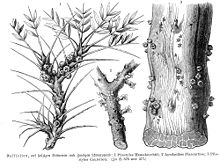
Royal Botanic Gardens, Kew is a non-departmental public body in the United Kingdom sponsored by the Department for Environment, Food and Rural Affairs. An internationally important botanical research and education institution, it employs 1,100 staff. Its board of trustees is chaired by Dame Amelia Fawcett.
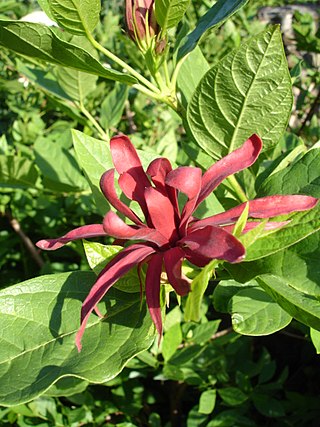
Calycanthus, called sweetshrub, is a genus of flowering plants in the family Calycanthaceae. The genus includes two to four species depending on taxonomic interpretation; three are accepted by most 21st century sources.
Aparisthmium is a plant genus of the family Euphorbiaceae first described as a genus in 1840. It contains only one known species, Aparisthmium cordatum, native to South America and Costa Rica.

Selenicereus, sometimes known as moonlight cactus, is a genus of epiphytic, lithophytic, and terrestrial cacti, found in Mexico, Central America, the Caribbean and northern South America. The term night-blooming cereus is also sometimes used, but this is also used for many night-blooming cacti, including Epiphyllum and Peniocereus. In 2017, the genus Hylocereus was brought into synonymy with Selenicereus. A number of species of Selenicereus produce fruit that is eaten. The fruit, known as pitaya or pitahaya in Spanish or as dragon fruit, may be collected from the wild or the plants may be cultivated.

Otto Wilhelm Sonder was a German botanist and pharmacist.

Ulmus castaneifoliaHemsley, the chestnut-leafed elm or multinerved elm, is a small deciduous tree found across much of China in broadleaved forests at elevations of 500–1,600 metres (1,600–5,200 ft).

Calamagrostis arundinacea is a species of bunch grass in the family Poaceae, native to Eurasia, China and India. Under its synonym Calamagrostis brachytricha it has gained the Royal Horticultural Society's Award of Garden Merit.

Thouinia is a genus of flowering plants in the family Sapindaceae. The genus is named for André Thouin, a French botanist. As of 2020 Kew's Plants of the World Online lists 27 species in the genus:
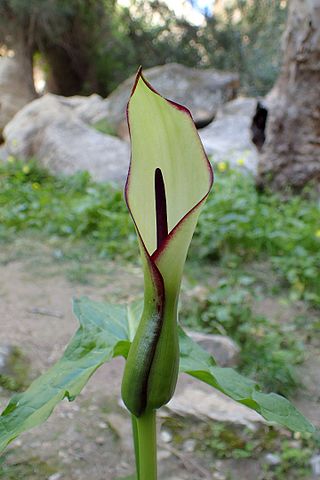
Arum hygrophilum is a species of flowering plant in the family Araceae. It has a disjunct distribution, found in Israel, Jordan, Lebanon, Syria, Cyprus and Morocco.
Miersiella is a monotypic genus of flowering plants in the Burmanniaceae, first described as a genus in 1903. It contains only one known species, Miersiella umbellataUrb. It is native to South America.
Yvonne Chuan Fang Su is a Hong Kong evolutionary biologist who is notable for her co-discovery of Pseuduvaria bruneiensis and Pseuduvaria borneensis. Her doctoral work at the University of Hong Kong focused on the phylogeny of the flowering plant genus Pseuduvaria. Her work as a faculty member at Duke–NUS Medical School focuses on the evolution of viruses.

Malachra is a genus of flowering plants in the family Malvaceae, native to the Americas and Africa, and introduced in places in Asia. They lack an epicalyx, an autapomorphy within their tribe Hibisceae, which is known for having epicalyces.
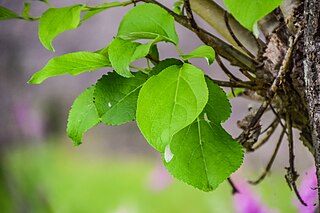
Populus suaveolens, called the Mongolian poplar, Korean poplar and Japanese poplar, is a species of flowering plant in the genus Populus, native to all of northern Asia, the Korean peninsula, the Kurils, and northern Japan. It is a tree reaching 30 m.
Gosong is a genus of flowering plants in the family Araceae. It has only one currently accepted species, Gosong brevipedunculata, native to Borneo. G. brevipedunculata is a rheophyte living alongside fast‑moving streams.

Talinopsis is a genus of flowering plants in the family Anacampserotaceae. It has only one currently accepted species, Talinopsis frutescens, native to the US states on New Mexico and Texas, and northeast, central and southwest Mexico. A succulent, it uses C3 carbon fixation.
Jailoloa is a genus of palm, in the subtribe Ptychospermatinae. It has only one currently accepted species, Jailoloa halmaherensis, native to the Moluccas. It only grows on ultramafic soils. The species is currently known only from its type locality in East Halmahera.
Wallaceodoxa is a genus of palm, in the subtribe Ptychospermatinae. It has only one currently accepted species, Wallaceodoxa raja-ampat, native to the Raja Ampat Islands off the Bird's Head Peninsula of New Guinea. It grows on limestone soils.

Iris × robusta, called the Windermere iris, is a hybrid species of flowering plant in the family Iridaceae. Its parents are Iris versicolor and Iris virginica, both of which are native to North America. Wild populations have been found in Michigan and Ontario, and it has been introduced into Great Britain. It is a rhizomatous perennial, characterised by its violet-blue flowers and purple-flushed foliage. It has a number of cultivars, including 'Gerald Darby', 'Mountain Brook', 'Purple Fan' and 'Nutfield Blue'. Its cultivar 'Dark Aura' has gained the Royal Horticultural Society's Award of Garden Merit.
Stevensia is a genus of flowering plants belonging to the family Rubiaceae.
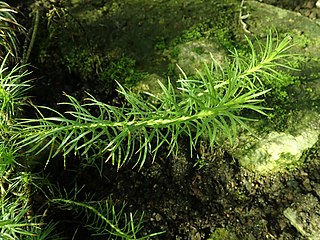
Fluminaria is a genus of flowering plants in the family Asteraceae. It has only one currently accepted species, Fluminaria pinifolia, native to Lesotho, and KwaZulu-Natal in South Africa. It prefers to live alongside streams in mountainous areas.
